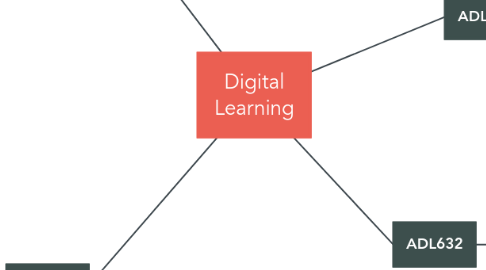
1. ADL634
1.1. Student Engagement
1.1.1. Students learn better when they are active (Pappas, 2017).
1.1.2. Use Bloom's Taxonomy as a reference
1.1.2.1. Bloom’s Taxonomy requires higher order thinking skills of application, analysis and synthesis (Morrison, 2012)
1.2. Building Upon my Moodle course
1.2.1. Creating a Course Outline
1.2.2. Adding Meaningful Activities
1.2.2.1. Survey
1.2.2.2. Assessments
1.2.2.3. Graphics
1.2.2.4. Online Games
1.2.2.5. Google Forums
1.3. Reflection of my peers' Moodle courses
1.3.1. great ideas
1.3.2. allowed for self reflection
2. ADL636
2.1. Types of Assessment
2.1.1. Formative
2.1.1.1. Formative assessment allows for growth (Stover, Yearta, & Harris, 2016).
2.1.2. Summative
2.1.2.1. Summative assessment takes places at the end of a unit and is compared against a standard, or benchmark (Carnegie Mellon University, 2016).
2.2. Final Reflection on Digital Literacy
2.2.1. ISTE Self Assessment
2.2.1.1. I still have standards I need to meet and work on.
2.2.2. Review of my Moodle course
2.2.2.1. My course is a work in progress.
2.2.2.2. I have added meaningful and relevant interactive activities.
2.3. Interview with Director of Assessment
2.3.1. Allowed for reflection of district assessments.
2.3.2. I came to the conclusion that our district is extremely data driven.
3. - ADL 630 Class Website. Retrieved from https://nu.blackboard.com/webapps/blackboard/ content/listContent.jsp?course_id=_67402_1&content_id=_4879028_1&mode=reset - Carnegie Mellon University (2016). What is the difference between formative and summativeassessment? Retrieved from https://www.cmu.edu/teaching/assessment/basics/formative-summative.html - Pappas, C. (2017). 6 instructional design tips to create engaging eLearning courses. Retrieved from https://elearningindustry.com/instructional-design-tips-create-engaging-enlightening-elearning-courses - Morrison, D. (2012). Learning online is not a spectator sport: how to make it active. Retrieved from https://onlinelearninginsights.wordpress.com/2012/09/22/learning-online-is-not-a-spectator-sport-how-to-make-it-active/. - Stover, K., Yearta, L., & Harris, C. (2016). Assessment in the digital age: Blogging with third graders. The Reading Teacher, 69 (4), 377-381. - TPACK Website. Retrieved from TPACK.org
4. ADL630
4.1. Formation of Moodle course.
4.2. Types of Learning
4.2.1. Cognitivism
4.2.1.1. Cognitivism occurs when learning is shifted from long term to short term memory through a “meaningful and organized way” (ADL630, n.d.)
4.2.2. Constructivism
4.2.2.1. Constructivism occurs when the learner is making meaning and constructing understanding through collaboration and doing (ADL 630, n.d.).
4.3. TPACK
4.3.1. TPACK is the basis of effective teaching with technology (TPACK, 2012)
5. ADL632
5.1. Coding Lesson
5.1.1. Using "Dash the Robot."
5.1.2. Using Screen Castify.
5.2. Pinterest Board
5.2.1. Pinning activities that would go into my Moodle Course.
5.3. Technological Tools
5.3.1. Learning about new technological tools to add to my Moodle Course.

